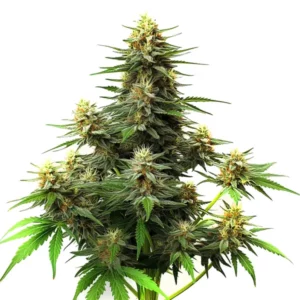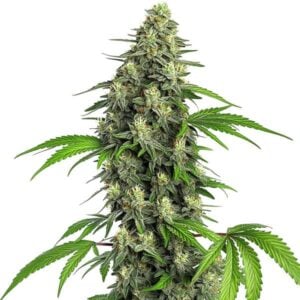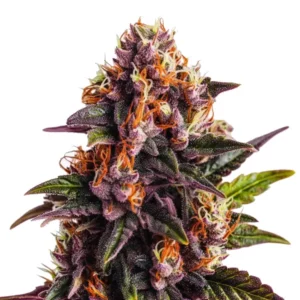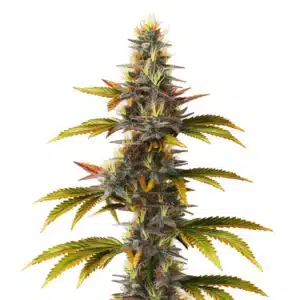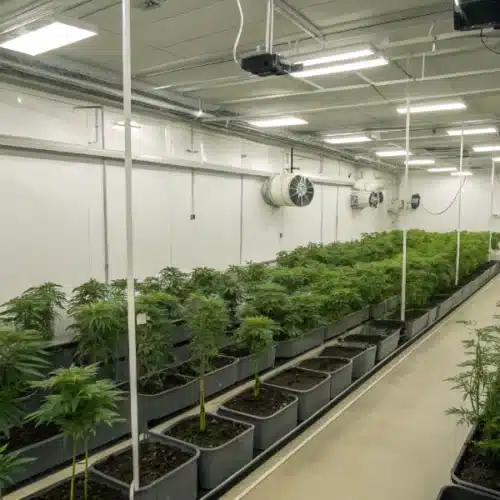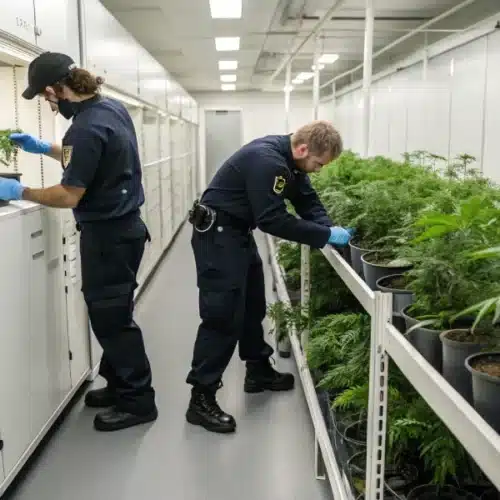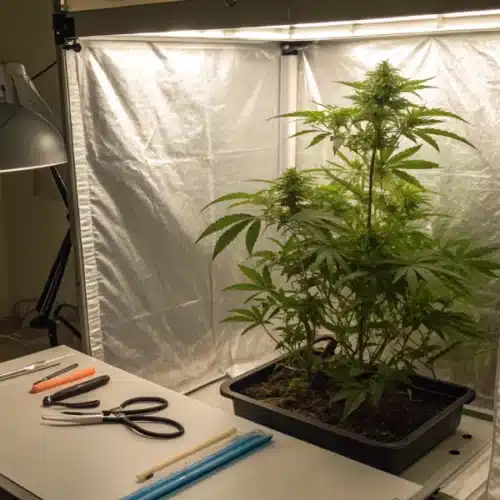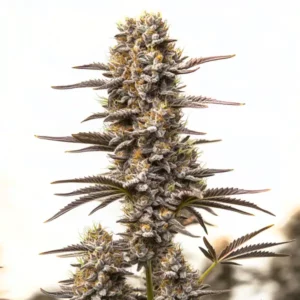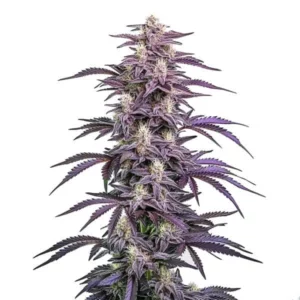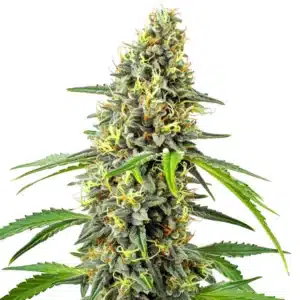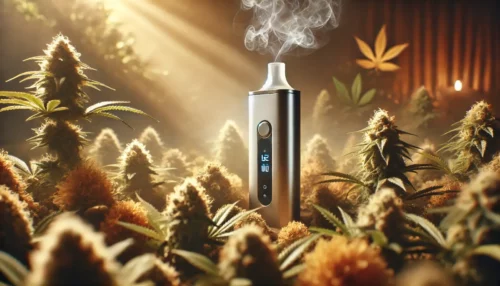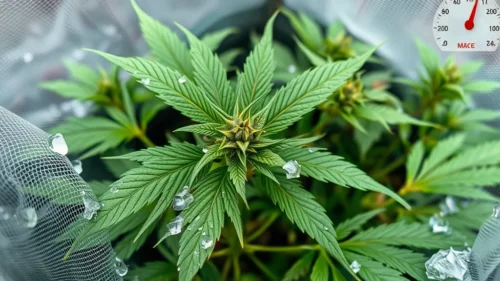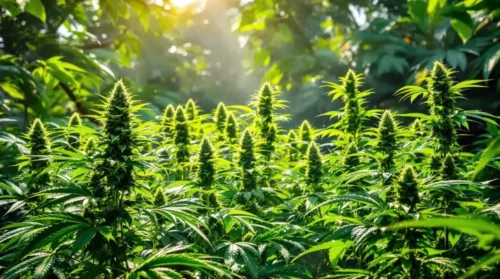Why Temperature Matters
Photosynthesis Efficiency
Warmth plays an essential part in how cannabis captures light energy and turns it into fuel. Inside each leaf, enzymes speed up carbon fixation when temperatures stay between 20 °C and 30 °C. That energy then powers cell division, leaf expansion, and root growth. Growers who maintain steady warmth see quicker stem growth and denser foliage, which boosts overall plant vigor and prepares the crop for larger flowers.
If temperatures drift outside this zone, enzyme reactions slow or stall. Too-cool air can leave leaves limp, cutting the rate of sugar formation. Too-hot air breaks down enzymes, leading to leaf discoloration and wilting. By setting the ideal temperature for cannabis throughout daylight hours, cultivators keep photosynthesis operating at full throttle, driving stronger, healthier plants.
Transpiration and Humidity Links
Every cannabis plant moves water upward through roots, stems, and leaves in a process known as transpiration. When air holds extra moisture at higher temperatures, leaves release water vapor more rapidly. That vapor exchange pulls nutrients from the soil, feeding growth at the canopy. Maintaining a balance between heat and humidity ensures plants stay hydrated without drowning.
However, if heat spikes combine with low humidity, plants slam stomata shut to save water. That closure chokes off nutrient flow and slows growth. By tracking both temperature and relative humidity, growers protect against sudden closing of leaf pores. This harmony between warmth and moisture supports nutrient uptake and prevents stress in each growth phase.
Stress Responses
Cannabis reacts strongly to prolonged swings in air temperature. When days or nights stray far from norms, plants divert energy to survival. They pump out stress hormones that slow growth, shrink internodes, and shrink yield potential. Signs of chronic stress include twisted leaves, burnt tips, and stunted branch development.
A stable grow environment reduces these threats. Keeping heat consistent forces plants to focus on bud development rather than dodging damage. Growers who dial in the ideal temperature for cannabis minimize stress triggers. That steady setting lets plants keep up vigorous expansion, leading to full flower production and heavier harvests.
Promos & Deals
Vegetative Stage Settings
Day vs. Night Temperatures
During the vegetative stage, cannabis responds best to warmer days and cooler nights. Aim for day highs of 24 °C to 28 °C while lights are on. Once lights switch off, lower night temps to 18 °C–22 °C. This controlled swing mimics outdoor conditions and signals plants to store energy, strengthening stems and encouraging healthy root systems.
Without a nighttime cool-down, triggers for bud set may fire too early, causing unwanted stretching. Warm nights also trap moisture, raising disease risk. By targeting that 6 °C to 8 °C drop each dark period, growers achieve compact growth, reducing pests and improving airflow around lower leaves and budding sites.
Optimal Light-On Period
When grow lights shine, maintaining the ideal temperature for cannabis keeps growth moving at peak speed. Under LED or HPS lamps, air around the canopy can climb rapidly. Fans should blow across top leaves to disperse hot pockets at canopy level. Try to hold temperatures between 24 °C and 28 °C during light periods to maximize nutrient uptake without stress.
Dropping below 22 °C under lights slows root activity and leaf expansion. If bulbs heat the room too much, raise lights or dim intensity. Conversely, if cold floors chill the canopy, bring lights closer or add mild warming. Keeping that sweet spot maintains strong photosynthesis and rapid stem elongation.
Impact on Leaf Development
In vegetative growth, leaf shape and size adapt to temperature trends. Consistent daytime warmth around 26 °C produces broad, flat leaves rich in chlorophyll. These large surfaces capture more light, boosting energy reserves for bud formation. Larger leaves also shade lower branches, promoting more even growth across the plant.
Cooler nights near 18 °C encourage thicker leaf tissue. That thickness helps leaves retain moisture and stand up to bright light without burning. Thin leaves in constant warmth absorb less light, cutting energy capture. By balancing day and night temps, growers shape foliage for maximum photosynthetic output and strong plant structure.
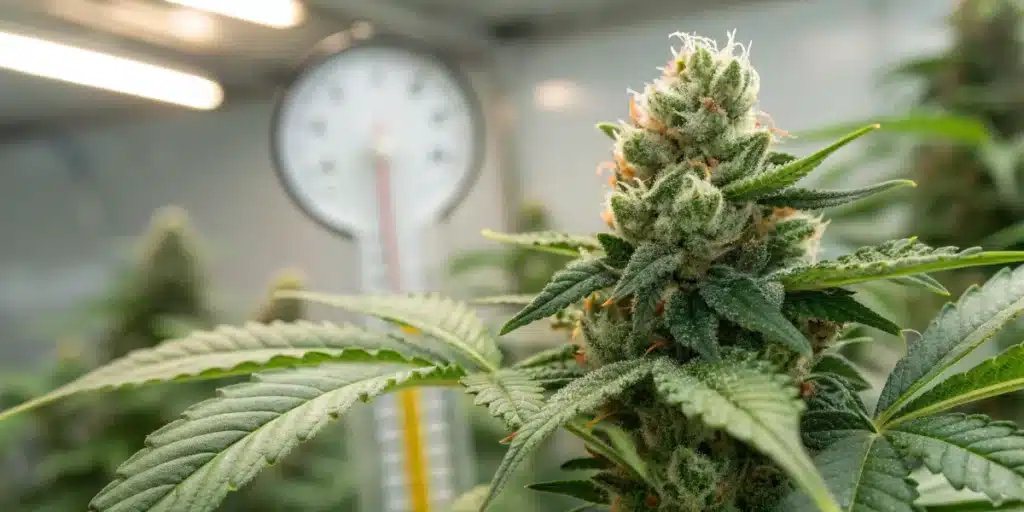
Flowering Stage Settings
Cooler Nights Advantages
Once flowering begins, reducing night temperatures by 4 °C to 6 °C compared to day levels drives resin production. Cooler darkness slows respiration, so plants keep more sugars in buds rather than burning them off. Those extra sugars feed trichome growth, thickening resin glands and intensifying cannabinoid content and aroma.
Maintaining 16 °C–18 °C nights also promotes vibrant pigmentation in some strains. Reds and purples may emerge as chlorophyll slows breakdown. Growers report sweeter flavors and sharper scent profiles when they adjust to these cooler nights. Just avoid sudden chills that risk shock; lower temps gradually to keep plants on track.
Daytime Heat Limits
During bloom, keep lights-on temperatures within a narrow range to preserve terpenes. Aim for 20 °C–26 °C at peak hours. When heat soars beyond 28 °C, volatile compounds break down and flowers may open prematurely. That volatilization cuts flavor quality and lowers potency in finished buds.
To prevent that, use air-cooled hoods or dimmer switches to limit bulb heat. Circulate fresh air from intake vents before it warms fully. If necessary, change light cycles or add supplemental shading. Consistent daylight warmth allows trichome-rich buds to swell without losing delicate aromatic oils.
Effects on Resin Production
Resin forms in glandular trichomes, and those glands respond quickly to temperature signals. Under stable daytime temps near 24 °C, trichome heads enlarge and fill with cannabinoids. When combined with 16 °C–18 °C nights, sugar reserves remain high, further fueling resin synthesis overnight.
If days climb too hot, trichomes may open and drop valuable terpenes. If nights stay too warm, plants burn off sugars needed for resin. By dialing in the ideal temperature for cannabis through bloom, cultivators maximize sticky gland counts and boost yield quality, preserving flavor and potency.
Environmental Controls
HVAC and Ventilation Tips
A reliable HVAC system maintains consistent temperature across the grow area. Position intake vents low to pull in cooler air and exhaust vents high to expel hot air. That airflow pattern flushes heat near lights and stops pockets of warm air from settling at canopy level.
Seal gaps around doors and windows to prevent outside heat or cold from sneaking in. Dirty filters can restrict airflow, causing uneven heating or cooling. Check and replace filters regularly, and consider adding duct insulation. These steps keep room temperature accurate and reduce energy costs.
Use of Heaters and Fans
In colder climates or off-seasons, ceramic or infrared heaters with built-in thermostats provide steady warmth. Place them away from leaves to avoid local hot spots. Let them cycle on and off to hold temperatures within a 2 °C band, reducing plant shock.
Fans do more than move air; they build stem strength by mimicking natural breezes. Oscillating fans at canopy height help equalize temperature across all plants. Set airflow to a gentle draft so leaves sway slightly. That motion prevents hotspots and encourages healthy vascular development.
Monitoring Tools and Sensors
Modern digital sensor arrays track temperature, humidity, and CO₂ levels simultaneously. Place sensors at canopy height and at root zone to detect microclimates. Connect them to wireless controllers that send alerts when readings slip outside set parameters.
Real-time dashboards display data and let growers tweak HVAC, fans, or humidifiers at the touch of a button. Some systems even adjust automatically based on thresholds. Continuous monitoring cuts down on surprises and keeps plants inside their target climate zone.
Dealing with Extremes
Heat Stress Prevention
During sudden heat waves, immediately reduce light intensity or shorten on-hours. Deploy emergency ventilation or portable air-conditioning before canopy temperatures climb above 30 °C. Light misting of leaves can add evaporative cooling, but avoid overwatering.
First signs of heat stress include wilting tips, drooping leaves, or leaf edge burn. At that point, increase airflow around the canopy, move fans closer, and lower light height if possible. Swift action prevents irreversible damage and keeps buds developing normally.
Cold Exposure Risks
If temperatures dip below 12 °C, root uptake slows and new shoots struggle to emerge. Prolonged cold can stunt plants or kill vulnerable clones. Use heater mats under trays to warm soil directly, ensuring roots stay active.
Nighttime cold snaps also raise moisture on leaves, increasing mold risk. Keep fans running gently during dark periods to stop dew from settling. Warm soil and moving air protect roots and foliage when nights turn too frigid.
Emergency Cooling/Heating Plans
Every grower should have backup equipment ready. Store a small propane or electric heater and a stand-alone fan or AC unit in the grow room. For cooling emergencies, ice packs in sealed containers near inlets can briefly lower intake temps if power fails.
Label each device clearly and outline quick-start steps on a laminated sheet. When an alarm sounds, you can deploy backups in under a minute. That preparation stops temperature excursions from crippling yields or causing crop loss.
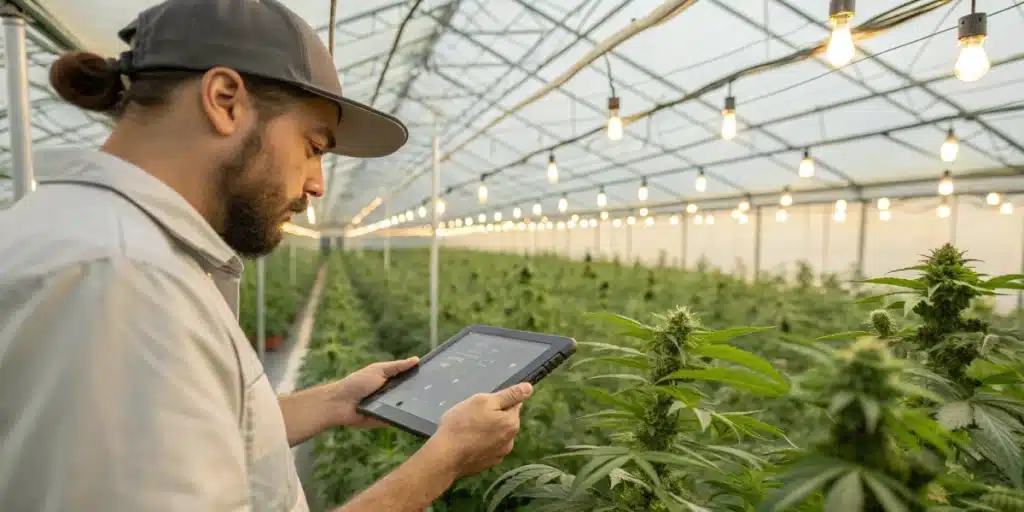
FAQs about ideal temperature for cannabis
What’s the best night temperature in bloom?
Aim for nights between 16 °C and 18 °C during the flowering phase. Cooler darkness slows respiration so sugars stay in buds and feed resin glands. This temperature band enhances trichome density and uplifts aroma, taste, and potency in the final harvest.
How do I measure canopy temperature?
Use an infrared thermometer held about 30 cm above the top leaves, scanning evenly across the canopy. That surface reading reflects what plants actually experience, which can differ from near-vent airflow. Taking multiple measurements gives an accurate average.
Can temperature swings improve resin?
Yes. A controlled 4 °C to 6 °C difference between day and night triggers excess sugar storage in buds. Warm days power photosynthesis, while cold nights keep sugars intact. This cycle boosts gland size and resin yield at harvest time.

